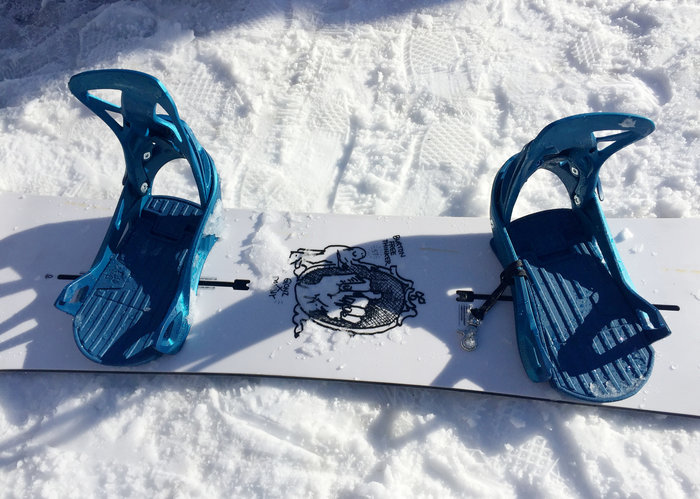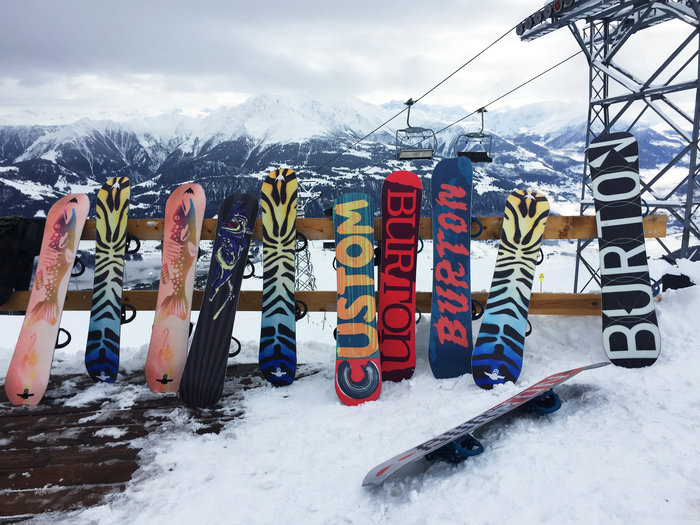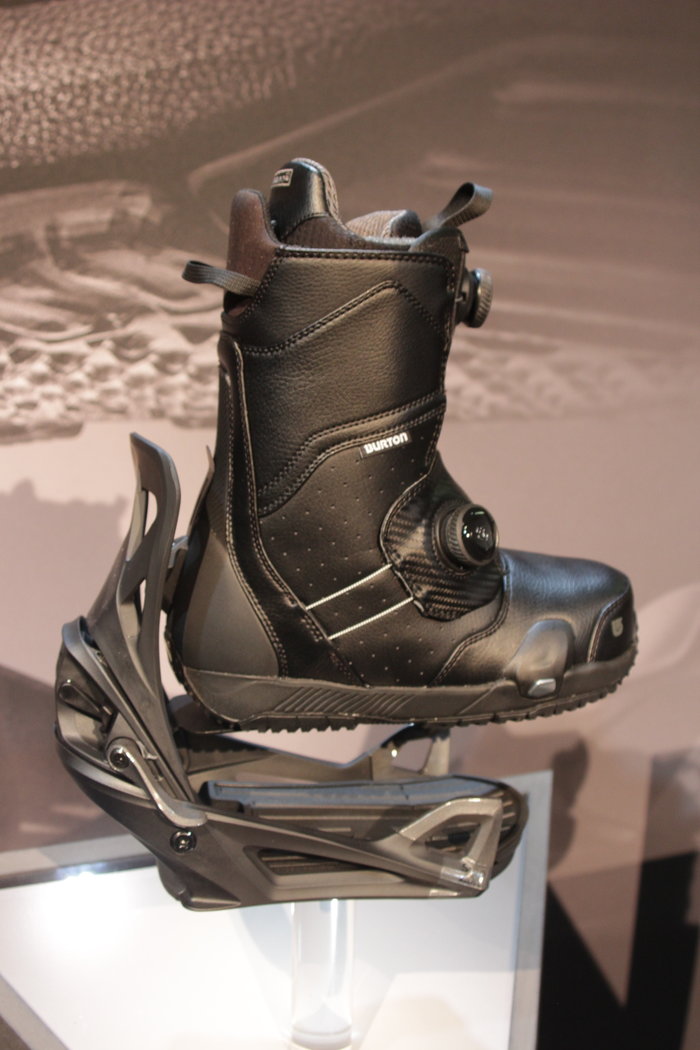Burton’s Step On Binding Launch, Images & Chris Fidler Interview
The Burton Europe team invited media and selected retailers to Laax, Switzerland to test Step On, their brand-new step-in binding interface. The system is a combination of boot and binding, locking in your heel and forefoot in a quick, safe and easy way. Burton claims that over the course of 10 years you get 300 extra runs because you save so much time compared to a common system. Sounds promising… SOURCE’s Barbara Mayer headed to Laax for the report, images and interview with Chris Fidler, Director of Product Management at Burton.

The men’s Step On binding on snow
Burton is seeding the product at its top retail partners, around 90 shops (excluding distributors) all over Europe, Bene Pelikan, Sales Director Europe, told SOURCE. The first edition of Step On will be very limited and Burton hope to sell out before Christmas next year. The Step On system is aimed for all levels of snowboarder, but two of the target groups are definitely returners looking for the quickness of ski bindings as well as the older generation of snowboarders wanting more comfort.
The Step On system features one binding and two Boa boots each for men and women with a RRP of 600 to 670 Euros for the package, and is set to hit retail for the 2017/18 winter season. Here’s what Chris Fidler, Director of Product Management, has told us about how Step On works, how the system was developed and why it took Burton four years of R&D until they finally felt the time was right to launch it.
What are the main benefits of the Step On system and how does it work?
It’s faster, saving you time meaning you can spend more time riding and less time messing around with your gear. It’s easier, you don’t have to use your hands, don’t have to sit down and most importantly, it’s on a level of performance that you would expect from Burton. Step On is the next level in the evolution of snowboarding.
One of the most important things when designing the boot was making sure we could get the same natural flex and feel that you get out of your current boot. We didn’t want to add anything that was adding a bunch of weight, making it stiff or uncomfortable, so we used the same construction that we’ve been using on our existing boots. That was really the cornerstone, making sure that we were getting the same level that you would expect from your traditional boot and binding system.
There are three points of connection on your boot, and as you step in, the first lever is going to position you into the binding and is going to completely lock you in, and then we have two more positions further down. So if you get a little snow under your foot or your binding and foot are a little mis-aligned, you can get into the first position and as you shift your foot and the snow is getting out from under it, you can put some weight on your heel and it’s going to continue to tighten down in position two and three.

Test boards
Then there’s a dual-zone strap over the middle of your foot that really allows you to tune the feel of the system. If you like a really stiff, aggressive ride, you can tighten this up, and if you like a more loose, kind of playful style, you can keep this a little bit looser. Also, you can adjust it on the fly.
The toe cleats are made out of a mixture of plastic and metal, plastic to make sure that we’re not interrupting the flex or creating any pressure points, and metal to make sure this thing is going to be durable and is going to hold on. There’s nothing underneath you foot, there are no dead spots, there’s nothing that would sacrifice any performance out of your boot.
For the binding, we are using the same injection technique that we normally use, we decided to build this in reflex, so they could be mounted on 4×4, 3D or channel, because we wanted this to be universally compatible with any board out there. We spent a lot of time making sure this is a very simple, elegant design. There are very few parts, it’s meant to look amazing but also be very durable and hold up. When you are ready to get out of the system, you can pop the release lever — you don’t have to hold onto it — and just step out of the binding, the lever will automatically set itself down again, so you can just step back into the binding whenever you want.
When you slide your boot into the binding, it engages with two clicks in the back, it’s the same technology that we use in smooth-glide buckles, we’ve been using it for years. As you click in, these lock in and hold you in the binding. So once you click in the first click, we’ve done all of our testing in that first click to make sure you are never coming out of that system and it’s fully secure. The toe hooks then engage the toe cleats on the boot, as you put weight on your toes, and then you have a fully engaged three-point system and three points to deliver energy directly from your heel to your toes, giving you a very responsive feel in this binding.

Burton Step On
How did the designing process and R&D work? And which type of snowboarder is Step On made for?
We’ve been doing a lot of work back at Burton, really trying to rethink how we go on working on innovation projects, how we manage large-scale projects that are designed to fundamentally change the way a customer experiences the snow. We have been playing around with some design-thinking methodologies, we’ve tried prints, but one of the things we did about four years ago to kick this project off was that we grabbed four people within product development and said: “Hey, you can work on a special project, come with us,” and explained that they could work on this project for the next four months, no other distractions, no emails, no meetings, no other projects. They got a physical space, went to the hardware store, bought all this stuff, put up a wall, brought all their stuff in, dogs and everything, and started to spend their whole time in there really trying to research this project.
At first glance, we had a pretty clear direction, we were looking to build a boot and binding system that was the next evolution of step-in, but we wanted to make sure it had the performance of your traditional strap binding and boots. That was their challenge and they really started to dive in to create a system that lived up to that level of performance. They started mounting cameras onto their boards and going to the mountains riding them, trying to see how the boot and binding interacted, what was the right feel and the right flex. They started doing a lot of laboratory tests to see how they were working and in the end they came up with this really long list of critical requirements that they felt were important to make sure they were getting the performance they wanted. Once they had that, they started concepting and ideating.
In the first three months those guys did more prototypes than I have ever seen, they were sketching new ideas, engineering new shapes, building them all over. We had 3D printing, hand mocking stuff up, every day there was a new idea, a new concept. By the end of the four months, they had ideated so much around how they could design the requirements that they came out with one concept and were convinced that this was the answer to the challenge.
Then we were starting to figure out all the nuts and bolts for this project, how we could make this thing work. For the last few years, our engineering team have been working on how to build this, how to manufacture it, how to make sure everything is going to hold up and with that, a huge part is on-snow testing. So this is the most extensive testing plan I think I’ve ever seen – and I’ve been at Burton for ten years and I think we have one of the biggest test plans in the entire industry. I think we’ve had more than 3000 hours of on-snow time, we’ve been riding this thing in multiple continents of the world, we’ve got 150 people signed up in our testing database testing this thing to make sure that it’s going to hold up, that it’s durable and functional and we’ve tested it in every ability and every terrain.
We’ve done a lot of testing with Terje and our team, we have a pretty strong internal team of testers. At the same time, we used this to make sure this would work for a wide team of snowboarders. We went up to Lake Tahoe and asked two people who were about to book a lesson. We offered to cover their lesson if they would be part of our experiment. We had them do two hours of learning on a conventional binding and boot and then two hours on Step On, brought them back, interviewed them and asked them what they liked – of course they preferred Step On.
We did all of this to make sure this thing worked – from somebody who was starting to snowboard to someone like Terje and our team riders and everything they ride. In the end we did more testing than we did with everything and we’re still not done.
Next up it was our turn to test the Step On system on snow, and to be honest, everyone – from retailers to media, from beginners to experts, from young to old, was stoked. Team riders Max Zebe, Hitsch Haller and Mikkel Bang were in Laax and showed off some one-footed tricks made possible by the new system.
As we heard before, Terje Haakonson is a great fan of Step On and rides it. Bene Heimstädt from Pleasure, Markus Fischer from GoPro and Onboard’s Tom Copsey don’t want to go back to their conventional binding and boots anymore, all being convinced that the new Burton system worked really well and that you couldn’t feel any difference to your usual setup. Fischi was even thinking about pre-ordering it.
Jerry from The Old Man Boardshop in Amsterdam had pre-ordered the Step On system without even knowing how it would look like and work, going purely on the marketing and on Burton’s word. Now he’s very happy with his decision, because like the other veteran testers, he really enjoyed riding the Step On. Being one of a few stores in the Netherlands offering the system next year, he is convinced he will sell it quickly. Martin from Hang Loose in Vienna was a little concerned that customers need to buy in to the whole system and buy boots and binding together, but they still wanted to give it a try and are offering Step On next year.





